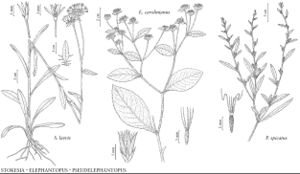Stokesia
Sert. Angl., 27. 1789.
| Taxon | Illustrator ⠉ | |
|---|---|---|
 | Stokesia laevis Elephantopus carolinianus Pseudelephantopus spicatus | Bee F. Gunn Bee F. Gunn Bee F. Gunn |
Perennials, 2–5+ dm; perhaps rhizomatous. Leaves basal and cauline; proximal petiolate, blades ovate to lanceolate or lance-linear; distal ± sessile, blades ovate or elliptic to lanceolate or lance-linear, bases ± clasping, margins entire or spinose-toothed; all with apices rounded to acute, faces glabrous or glabrate, resin-gland-dotted. Heads pseudo-radiant (see here at corollas), ± pedunculate, not individually bracteate; borne singly or in loose, ± corymbiform arrays 6–12 cm diam. Involucres ± hemispheric, 25–45 mm diam. Phyllaries 25–35+ in 5–7 series, the outer with appressed, ± chartaceous bases, distally ± foliaceous, margins pectinately spiny-toothed (at least at base), inner ± chartaceous throughout, mostly entire, faces ± tomentulose and resin-gland-dotted. Florets 12–35 (–70+); corollas usually blue to purplish blue (rarely white or lilac), tubes longer than funnelform throats, lobes 5, lance-linear (in peripheral florets adaxial sinus much deeper than others and corollas zygomorphic, ± raylike or ligulelike, in central florets corollas ± actinomorphic). Cypselae ± columnar, 3–4-angled, glabrous; pappi caducous, of 4–5 scales. x = 7.
Distribution
se United States
Discussion
Species 1.
Selected References
None.
Lower Taxa
"dm" is not declared as a valid unit of measurement for this property.